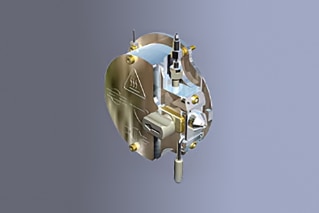Electron Transfer Dissociation (ETD)
Analyze post-translational modifications and top-down biomolecule sequencing
Developed specifically to maximize confidence, flexibility, and ease-of-use, the Electron Transfer Dissociation (ETD) capability upgrade, for use exclusively with electrospray ionization, provides a powerful platform for the sequencing and structural analysis of peptides and proteins.
Complementary to Collision Induced Dissociation (CID), ETD has proved particularly useful for the site-specific determination of sites of labile post-translational modifications (PTMs) of peptides and proteins. ETD is a radical-driven fragmentation technique, resulting in cleavage of the peptide N-Cα bond to give c and z● peptide product ions (cf. b and y” ions using CID), enabling the precise localization of sites of phosphorylation. Peptides/proteins are dissociated by electron transfer from a donor chemical anion, to positively charged cations, which leads to an inherently similar fragmentation process to electron capture dissociation (ECD).
Overview
- High performance - High resolution, exact mass data, and high reaction efficiency generate the highest quality sequence data.
- Flexibility -Utilizes a range of high-efficiency reagents as well as employing Ion Mobility Separations (IMS) with ETD for advanced fundamental studies. Suitable for use with both conventional and nanoFlow electrospray ion sources.
- Easy-to use and maintain - Easy, stable introduction, and fast replenishment of ETD reagent to the MS through the simplicity of the ETD glow discharge source.
ETD source operation
The ESI source incorporates a fast and efficient intermediate pressure glow discharge reagent anion source. During the ETD experiment, cations and anions are sequentially generated. The ion source polarity and quadrupole set mass are switched to deliver multiply charged precursor cations followed by singly-charged reagent radical anions (usually from 1,4-dicyanobenzene [m/z 128]) into the Trap T-Wave ion guide, where they interact to form ETD product ions.
Reagent anions formed in a glow-discharge source are trapped in the instrument’s Triwave Trap T-Wave ion guide, where they undergo rapid electron-transfer reaction with analyte ions. Multiply charged peptide ions fragment by ETD to give predominantly c-fragment and z-fragment ions.
The formation and trapping of the reagent anions, and formation and reaction of sample ions are separate processes. When operating in ETD mode, the instrument alternates between a glow-discharge mode that effectively refills the Trap T-Wave ion guide with anions and an ESI mode that ionizes the sample and reacts it with the ETD reagent anions.
During acquisition, the Trap T-Wave ionguide is used exclusively for ETD, but the Transfer T-Wave ion guide remains available for CID. It is therefore possible to acquire both ETD and CID data in the same experiment.
Instrument compatibility
The Electron Transfer Dissociation (ETD) capability upgrade is available for the following instruments:
- (MALDI) SYNAPT G2 MS, (MALDI) SYNAPT G2 HDMS
- (MALDI) SYNAPT G2-S MS, (MALDI) SYNAPT G2-S HDMS
- (MALDI) SYNAPT G2-Si MS, (MALDI) SYNAPT G2-Si HDMS
Two different upgrade products are available for each SYNAPT instrument type, except for SYNAPT G2-Si. This is to accommodate those instruments that are not ‘ETD ready’. ETD ready instruments can be identified by their serial number prefix. All SYNAPT G2-Si instruments are 'ETD ready'.
Early SYNAPT G2 series MALDI instruments may also require a replacement ETD compatible MALDI source adaptor plate.
Equipment and installation
The Electron Transfer Dissociation (ETD) capability field upgrade comprises the following:
- ETD glow-discharge ion source and discharge pin.
- Reagent sample holder lid, gas handling hardware, and valves.
- Replacement source pcb assembly, Trap and Transfer T-Wave power supplies, ETD wiring harness, and additional software. (Early SYNAPT G2 instruments)
- Replacement source transfer pcb assembly and additional software (Early SYNAPT G2-S instruments)
- Operation manuals and test chemicals.
Installation, performance confirmation, and operation training by a Waters Field Service Engineer is required.
